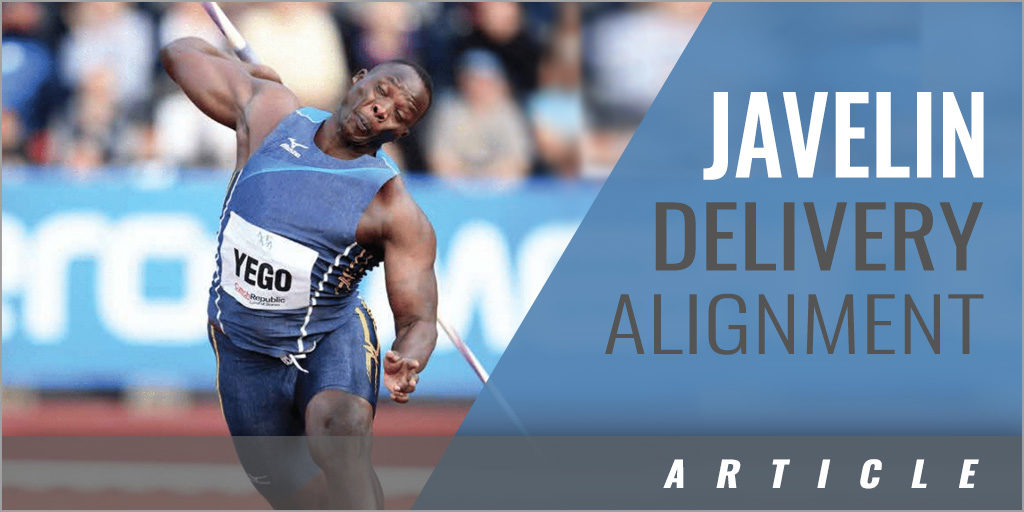|
By: Kurt Dunkel, MS Originally Published in: Techniques Magazine Provided by: USTFCCCA
The 2017 Men's Javelin Final at the IAAF World Championships in London saw the top four finishers represent two countries and two different technical approaches to throwing the javelin. German throwers Johannes Vetter and Thomas Rohler employed a 'linear' delivery en route to finishing 1st and 4th respectively. On the other hand, Czech throwers Jakub Vadlech and Petr Frydrych employed a non-linear ('wrap') approach and delivery and finished 2nd and 3rd respectively. The German throwers did not perform near their personal bests; whereas the Czech throwers both achieved personal bests in the final. What are the differences between these two styles of throwing? Is one better than the other? In what ways may have javelin alignment contributed to the performances of the German and Czech throwers? What do coaches and throwers need to understand in order to best support technical growth, change, and development? This article will explore these questions and topics in greater depth in order to illustrate a clearer picture of the differences between javelin delivery alignment. Creating delivery speed and transferring this speed into the javelin in a manner which increases the distance thrown is the fundamental goal for a javelin thrower. Although science and coaching wisdom both tell us that a javelin thrower should seek to throw the javelin "through the point," this idea deserves further exploration because the number of complex variables in the javelin throw demonstrate that transferring energy in a linear fashion (i.e. through the point) is not a simple and straightforward scenario. The relationship between the development of delivery speed (energy) and the transfer of this energy into the javelin in an efficient method which will increase the distance thrown is a very complex puzzle. The fundamental biomechanical challenge is that the body and the movement of the arm are not naturally suited to propel a linear object. Various approaches have seen varying degrees of success and over time, and a basic, fundamental throwing technique has evolved. Generally speaking, the fundamental throwing technique is one that throwers and coaches study and attempt to emulate. The individual nuances in throwing styles can be attributed to a variety of factors, which include: the unique biomechanical / neuromuscular strengths / weaknesses of the The basic, fundamental throwing technique is a method to create linear energy (via a run and crossover strides), and to then transfer this energy into the javelin by bracing the lower and upper non-throwing side of the body and deliver the javelin with an overhand throwing movement. By employing this fundamental throwing technique, the javelin thrower attempts to take full advantage of the laws of physics and biomechanics. There are some variations and nuances within the fundamental throwing technique that play a significant role in "WRAP" VERSUS "LINEAR" STYLE OF THROWING During the crossover and delivery phases, some javelin throwers choose to align the javelin in a linear fashion - oriented toward the center of the throwing sector. Others align the javelin more toward the throwing side sector line - for example, toward the right sector line for a right-handed thrower. These alignments are seen at varying degrees at varying points of the approach and delivery. The latter alignment style is often referred to as wrapping the javelin. Given that both approaches have seen significant success at the world-class level, it is useful to explore the pros and cons of each approach as well as the unique differences and variations between the two. These two styles of throwing can be seen most clearly when studying the elite throwers of Germany and the Czech Republic; two countries which have dominated javelin throwing in recent history. Although there are exceptions, German throwers often tend to be larger, more powerful, and employ more of a linear throwing style - as evidenced by Boris Henry, Andreas Hofmann, Stefi Nerius, and Johannes Vetter. Thomas Rohler and Christina Obergfoll tend to deviate a bit from center on the cross-overs but throw with a fairly linear orientation. German World Champion Matthias de Zordo is a notable exception that used a very pronounced wrap style. Generally speaking, the German training approaches obviously mirror this philosophy - as they work toward developing a powerful, elbow-dominated, linear arm strike. For the more linear javelin throwers, the path of the elbow strike is ideally mirroring the angle of attack. Because of this, shoulder power is at a premium. In comparison, javelin throwers from The Czech Republic often throw with a wrap style that is emblematic of World Record Holder Jan Zelezny - who has coached Petr Frydrych, Jakub Vadlejch, Barbora Spotokova, and Viterslav Vesely. To varying degrees, these throwers align and deliver the javelin more toward the throwing side sector. The delivery differs from their German counterparts in THE IMPORTANCE OF JAVELIN ALIGNMENT Javelin positioning is critical for both linear or wrap javelin thrower. Specifically, javelin alignment is significant for two primary reasons. First, physiology and biomechanics tell us that proper positioning of the javelin can aid in setting up the body for the strike on the javelin. Linear and wrap throwers want to eliminate excessive up and down movement of the javelin throughout crossovers and penultimate stride. Both throwers also want the javelin to move into a position, which is most effective for muscle engagement directly before block foot touch down. If the wrap-style thrower employs the correct timing / positioning of the block shoulder, then the orientation of the javelin naturally holds back or momentarily delays the strike. Some coaches and athletes feel this type of stretch is more effective in creating elastic potential energy and specific shoulder engagement. This extra degree of rotational elasticity has the potential to produce critical delivery speed. One challenge with a wrap-style delivery orientation is whether the thrower can position the block foot quickly and securely enough to ensure that the impulse is placed into the javelin such that the release occurs early enough that the thrower doesn't prematurely drift the non-throwing side of the torso so far forward that the throw is "missed." Javelin alignment is also significant from a physics standpoint: A rudimentary understanding of aerodynamics and physics would tell us that a linear alignment has the potential to create positive conditions for javelin flight, as well as the opportunity for energy transfer through the point of the javelin. For example, a javelin which is flying in a linear direction (like an arrow) has less surface area interacting with air, which slows the javelin. Improved lift can also be attained with the appropriate release angle. Coaches and athletes often focus on the set-up and delivery of the throw. However, one of the most critical aspects of the javelin throw is during the period of time when it is not in the hands of the thrower: the flight. Because the javelin is a linear object, its flight path may not completely align with its flight orientation, particularly for the initial portion of the flight. Also, accuracy is not a significant factor in the javelin competition, so it is not as important to aim the javelin. The most important factors are creation of the highest possible release velocity and attempting to couple that release velocity with the flight path orientation that is the most effective for that particular thrower. This can essentially be seen as a matrix. It takes knowledge, experience, and experimentation on both the coach and athlete's part in order to find the correct matrix. An example of the importance of release velocity can be seen in the example in which a javelin that rattles and plows horizontally or vertically could theoretically fly further than a throw with an ideal, stable, still, linear flight. This would be because the release velocity in the former was significant enough to compensate for the flaws in flight aerodynamics of the latter. This is analogous to the matrix of horsepower and aerodynamics in automobiles. The sports car with the lowest coefficient of drag can be defeated by a vehicle with significantly superior horsepower irrespective of its aerodynamic qualities. A common and very logical question that may arise when considering a wrap style approach is in regard to the sector line orientation. Specifically, if the javelin is aligned with the throwing side sector line (or even outside of the sector line), then why are there not more sector fouls? The answer is three-fold: First, when throwing a javelin, force is not transferred in a perfectly linear fashion. The arm produces velocity, which is rotational in nature. The thrower is attempting, ideally, to transfer as much energy as possible to propel the javelin the farthest distance. This energy is ultimately directed with an orientation toward the throwing sector even if the javelin is not. Simply put, this is why the javelin ultimately lands in the throwing sector. Second, because of the linear shape of the javelin, it exhibits a unique and very important tendency to 'self-correct' during its flight. The shape and weight distribution of the javelin causes it to change its orientation during flight. It tends to move away from the direction in which it is oriented and increasingly toward the direction in which it is thrown. Third, even an extreme wrap in the crossover phase of the run-up will tend to see the javelin begin to orient a bit more toward the center of the sector before release. This is a natural part of the throwing motion. However, it is still common for the javelin to be released with a sector line orientation, but this occurs in varying degrees for each individual thrower. Although some may legitimately assert a linear approach to delivering the javelin has the potential to transfer a greater percentage of force more efficiently through the point of the javelin, then how do we account for throwers who have thrown exceptionally far with a wrap-style approach / sector line orientation? For example, Johannes Vetter and Thomas Rohler have thrown over 93 meters with a mid-sector orientation and delivery. Steve Backley broke the world record and Aki Parviainen threw over 93 meters with a linear delivery. Conversely, Jan Zelezny employed a nonlinear delivery en route to becoming the greatest javelin thrower ever. Matthias de Zordo employed an extreme wrap style to win Gold at the World Championships. Julius Yego has thrown over 90 meters multiple times and won a World Championship and Olympic Silver Medal with a release that was sector line oriented. Some throwers are a bit of a hybrid in the sense that they employ a wrap in the crossover phase but a more linear delivery. For example, Sergey Makarov employed a wrap during his crossovers presumably in order to keep his torso closed and keep his chest back as he set up the throw. However, his arm strike was more linear with a high, overhead release. POSITION & MOVEMENT OF THE FEET, HIPS, AND SHOULDERS Javelin alignment in the crossover and delivery phase is related to two other very important factors, which a coach should understand. Each coach and athlete should find a technique which maximizes the unique abilities of the athlete. The movement of the arm through the throw is a critical and difficult to understand aspect of the throw. Javelin throwers have had a great deal of success with a variety of different delivery motions. Some prefer a high, over-the-top style such as Backley, Makarov, and Viljoen. They tend to drop the non-throwing shoulder during the delivery to push the throwing arm high, which necessitates a linear delivery. Some tend to initiate the throw with a level shoulder angle and a sector-line orientation (Kolak, Zelezny, Vadlejch), and others tend to initiate the throw with a level shoulder angle with the javelin in a linear position (Vetter, Rohler, Obergfoll). The placement of the block leg/foot and the motion of the hips also has a relationship with the delivery of the javelin as each athlete attempts to gain as much elastic stretch from the body as possible. Some attempt to employ linear hip drive with a wrap orientation. Rohler and Obergfoll tend to keep the javelin linear while attempting to put the block leg in a wide position and push the throwing hip forward. Throwers who tend to strike the javelin with an over the top, linear delivery tend to generally keep a neutral base with the block leg. However they tend to try to drive the throwing hip upward into the throw. It is logical and safe to assert that a wrap or linear style can both yield positive results for a thrower. As a coach, whether you are teaching new habits to a new javelin thrower or refining the technique of an experienced thrower, there are a few important things to keep in mind during the process. FOR THE COACH It is important to understand the pros and cons of each approach, and the strengths and limitations of your thrower. Generally, a linear orientation and delivery can:
Generally, a wrap orientation and delivery can:
The javelin throw is a results-dominated endeavor. So, the distance thrown will be the ultimate determiner of the approach the athlete and coach utilize. There are some other results that a coach and athlete should consider as well:
It is important to understand the strengths and limitations of your athlete. Do their physical attributes, neuromuscular habits, background, previous coaching, and abilities make them an obvious fit for one style over another? Are they able to experiment with different delivery angles? It is important to, if possible, experiment with different techniques, which includes delivery orientation. This takes a degree of knowledge and patience on the part of both the athlete and the coach. If you study the careers of elite throwers, you will be able to see the nuances, progression, and evolution of their technique. You will also be able to compare their results to their technical approach at that time. TIPS It is important to understand the difference between a wrap approach and a non-linear delivery. Generally speaking, coaches, teammates, and spectators observe the javelin from the side. This means they are missing out on a great deal of incredibly helpful technical data. Observing the thrower from the rear (or even front) can provide important knowledge about javelin alignment, shoulder angle, foot placement, and arm angle. These are critical data points that can be best / only observed from the rear or front. Understanding and observing the path of the elbow strike and relation of the forearm and the javelin throughout the delivery of the javelin. The movement and positioning of the elbow / arm in relation to the javelin is the most fundamental difference between these two techniques. Understanding the unique differences between how each technique is set up with the lower body - as the leg and foot action, timing, and positioning is unique for each style. Collaborate and communicate with your athlete as you explore the best javelin alignment. Feedback from your athlete is critical as you collaborate. The coach and athlete should balance the willingness to experiment with variations in technique with a willingness to commit to and move forward with the style that proves most beneficial across the board. Longer throws come with solid technique, commitment, repetition, and the correct mentality. There are numerous factors which influence the distance of a throw. A holistic approach to and under-standing of javelin technique is critical to the success of a javelin coach. Javelin alignment is a critical factor in determining how the energy created by the run-up is ultimately transferred into the javelin itself. A coach who fails to grasp this is 'missing the point'. KURT DUNKEL IS AN ASSISTANT THROWS COACH AT SHIPPENSBURG UNIVERSITY WHERE HE PRIMARILY WORKS WITH JAVELIN THROWERS. KURT WAS A TWO-TIME NCAA RUNNER-UP IN THE JAVELIN AND HAS COACHED AT HIS ALMA MATER FOR THE PAST 19 YEARS, DURING WHICH TIME HE HAS COACHED SU JAVELIN THROWERS TO 21 ALL-AMERICA HONORS INCLUDING ONE NCAA CHAMPION. IN 2017, SHIPPENSBURG UNIVERSITY WAS RANKED THE TOP JAVELIN PROGRAM (COMBINED MEN & WOMEN) IN DIVISION II BASED ON THE USTFCCCA RANKINGS. KURT HAS WRITTEN EXTENSIVELY ON THE TOPIC OF THE JAVELIN AND HAS ALSO BEEN A PRESENTER AT THE USTFCCCA CONVENTION. |








